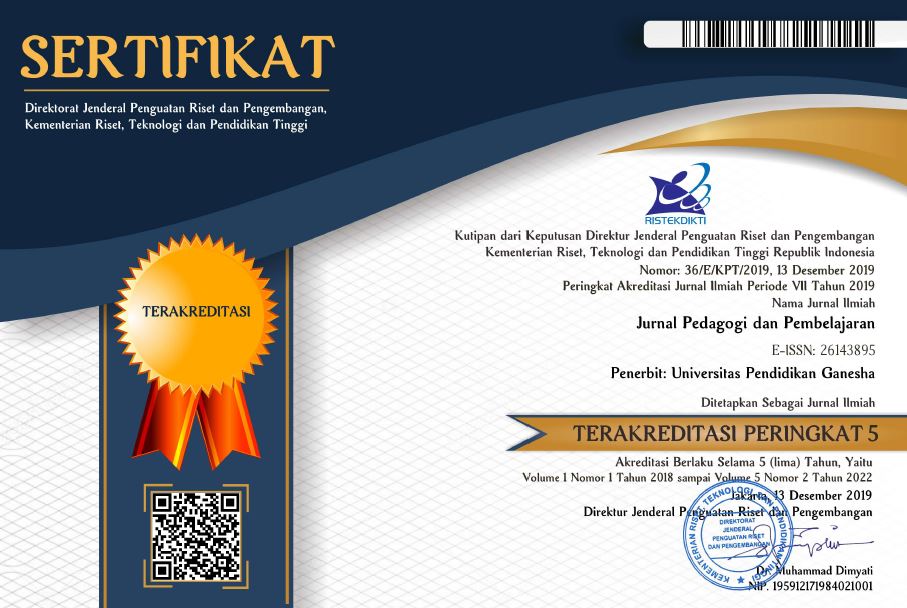Code Mixing for Beginner Japanese Language Learners at Mirai Mandiri
DOI:
https://doi.org/10.23887/jp2.v6i1.59624Kata Kunci:
Campur Kode, Pembelajar Bahasa JepangAbstrak
In a bilingual society, language contact always occurs along with misunderstandings in conveying messages or information. The purpose of this research is to find out the use of code mixing in the interaction process between elementary school students who are taking a Japanese language course for beginner classes and teachers at the Mirai Mandiri Japanese Language Course, the type of code-mixing that is spoken and the form of grammatical code-mixing phenomenon to be used in communicating process. This study uses a qualitative descriptive method. The research subjects were 15 elementary school students who were members of elementary level class groups, as well as a Japanese language teacher. The data collection technique used is the Uninvolved Conversation Observation Technique. Methods of data analysis using the equivalent method. The results of this study are that there are three types of code mixing used by elementary school students who learn Japanese as beginners when interacting with teachers or when interacting with fellow friends. The types of code mixing used are outer, inner, and mixed code-mixing. The used grammatical form is insertion.
Referensi
Ahmad, F. H. (2015). Sociolinguistics In Language Teaching. Mabasan, 9(2), 66–77. https://doi.org/10.26499/mab.v9i2.159
Asrifan, A., Abdullah, H., Muthmainnah, M., & Patil, A. (2021). An Analysis of Code Mixing in the MOVIE “From London to Bali.” ENGLISH FRANCA: Academic Journal of English Language and Education, 5(2), 317–338. https://doi.org/10.29240/ef.v5i2.2619 DOI: https://doi.org/10.29240/ef.v5i2.2619
Barnes, E. M., Grifenhagen, J. F., & Dickinson, D. K. (2016). Academic language in early childhood classrooms. The Reading Teacher, 70(1), 39–48. https://doi.org/10.1002/trtr.1463 DOI: https://doi.org/10.1002/trtr.1463
Bozorgian, H., & Fallahpour, S. (2015). Teachers’ and students’ amount and purpose of L1 use: English as foreign language (EFL) classrooms in Iran. Iranian Journal of Language Teaching Research, 3(2), 67–81. https://doi.org/10.30466/IJLTR.2015.20390
Colina, S., & Lafford, B. A. (2017). Translation in Spanish language teaching: The integration of a “fifth skill” in the second language curriculum. Journal of Spanish Language Teaching, 4(2), 110–123. https://doi.org/10.1080/23247797.2017.1407127 DOI: https://doi.org/10.1080/23247797.2017.1407127
Dang, T. C. T., & Seals, C. (2018). An evaluation of primary English textbooks in Vietnam: A sociolinguistic perspective. TESOL Journal, 9(1), 93–113. https://doi.org/10.1002/tesj.309 DOI: https://doi.org/10.1002/tesj.309
Enisa, M. E. D. E., & DİLİLİTAŞ, K. (2015). Teaching and learning sociolinguistic competence: Teachers’ critical perceptions. Participatory Educational Research, 2(3), 14–31. https://doi.org/10.17275/per.15.29.2.3 DOI: https://doi.org/10.17275/per.15.29.2.3
Hasanah, L., Pradina, S., Hadita, A., & Putri, W. C. (2019). Sociolinguistic Influence in the Use of English as a Second Language (ESL) Classroom: Seeing from Onovughe’s (2012) Perspective. Elsya: Journal of English Language Studies, 1(1), 28–32. https://doi.org/10.31849/elsya.v1i1.2538
Herdiawan, R. D. (2017). The Contributive Roles of Bilingualism in English Language Teaching. Journal of English Language Learning, 1(1). https://doi.org/10.31949/jell.v1i1.874
Hu, Y., Afzaal, M., & Alfadda, H. (2022). The Perceptions of International Learners Toward Teacher Code-Switching in the Elementary and Intermediate Chinese Foreign Language Classrooms. Frontiers in Psychology, 13, 1492. https://doi.org/10.3389/fpsyg.2022.860567 DOI: https://doi.org/10.3389/fpsyg.2022.860567
Jailani, M., Rusdarti, R., & Sudarma, K. (2017). Pengaruh kewirausahaan, motivasi belajar, sosial ekonomi orang tua dan self efficacy terhadap minat berwirausaha siswa. Journal of Economic Education, 6(1), 52–59. https://doi.org/10.15294/JEEC.V6I1.14701
Jayanti, D., & Sujarwo, A. (2019). Bilingual education in Indonesia: Between idealism and the reality. Script Journal: Journal of Linguistic and English Teaching, 4(1), 12. https://doi.org/10.24903/sj.v4i1.271
Lestari, M., & Wahyudin, A. Y. (2020). Language learning strategies of undergraduate EFL students. Journal of English Language Teaching and Learning, 1(1), 25–30. https://doi.org/10.33365/jeltl.v1i1.242 DOI: https://doi.org/10.33365/jeltl.v1i1.242
Ma, J. (2020). Code-switching Analysis in TCFL Classroom from the Perspective of Sociolinguistics. Theory and Practice in Language Studies, 10(12), 1551–1557. https://doi.org/10.17507/tpls.1012.06
Mulyajati, E. (2018). The Indonesian-English code-mixing in Just Alvin show at Metro tv. Journal of English Language and Culture, 7(2). https://doi.org/10.30813/jelc.v7i2.1024 DOI: https://doi.org/10.30813/jelc.v7i2.1024
Nadhifah, T., & Haristiani, N. (2022). Analysis of Code-Switching and Code-Mixing of Indonesian Japanese Learners. Sixth International Conference on Language, Literature, Culture, and Education (ICOLLITE 2022), 569–574.
Okamoto, T., Ratna, M. P., & Trahutami, S. I. (2021). The Use Of" Minato" As A Character Learning Self-Study Application And Its Effects: An Introduction To Beginner Japanese Language Learners At Indonesian Higher Education Institution. Kiryoku, 5(1), 74–79. https://doi.org/10.14710/kiryoku.v5i1.74-79 DOI: https://doi.org/10.14710/kiryoku.v5i1.74-79
Palmer, D., Henderson, K., Wall, D., Zúñiga, C. E., & Berthelsen, S. (2016). Team teaching among mixed messages: Implementing two-way dual language bilingual education at third grade in Texas. Language Policy, 15, 393–413. https://doi.org/10.1007/s10993-015-9361-3 DOI: https://doi.org/10.1007/s10993-015-9361-3
Pavón Vázquez, V., & Ramos Ordóñez, M. D. C. (2019). Describing the use of the L1 in CLIL: an analysis of L1 communication strategies in classroom interaction. International Journal of Bilingual Education and Bilingualism, 22(1), 35–48. https://doi.org/10.1080/13670050.2018.1511681 DOI: https://doi.org/10.1080/13670050.2018.1511681
Ramzan, M., Aziz, A., & Ghaffar, M. (2021). A study of code-mixing and code-switching (Urdu and Punjabi) in children’s early speech. Journal of Language and Linguistic Studies, 17(2), 869–881. https://doi.org/10.3316/informit.216304495772762 DOI: https://doi.org/10.52462/jlls.60
Rashidi, N., & Meihami, H. (2016). Hidden curriculum: An analysis of cultural content of the ELT textbooks in inner, outer, and expanding circle countries. Cogent Education, 3(1), 1212455. https://doi.org/10.1080/2331186X.2016.1212455 DOI: https://doi.org/10.1080/2331186X.2016.1212455
Ravindranath Abtahian, M., Cohn, A. C., & Pepinsky, T. (2016). Modeling social factors in language shift. International Journal of the Sociology of Language, 2016(242). https://doi.org/10.1515/ijsl-2016-0036 DOI: https://doi.org/10.1515/ijsl-2016-0036
Reswari, G. P. A. (2020). Bahasa Jepang vs Bahasa Inggris sebagai Bahasa Asing dalam Persepsi Mahasiswa Indonesia. KIRYOKU, 4(2), 130–136. https://doi.org/10.14710/kiryoku.v4i2.130-136
Sankar, D. K. (2022). A Theoretical Review: Sociolinguistics in Second Language Education. International Journal of English Literature and Social Sciences, 7(1). https://doi.org/10.22161/ijels
Silverstein, M. (2015). How language communities intersect: Is “superdiversity” an incremental or transformative condition? Language & Communication, 44, 7–18. https://doi.org/10.1016/j.langcom.2014.10.015 DOI: https://doi.org/10.1016/j.langcom.2014.10.015
Siridetkoon, P., & Dewaele, J. M. (2018). Ideal self and ought-to self of simultaneous learners of multiple foreign languages. International Journal of Multilingualism, 15(4), 313–328. https://doi.org/10.1080/14790718.2017.1293063 DOI: https://doi.org/10.1080/14790718.2017.1293063
Sundari, H. (2017). Classroom interaction in teaching English as foreign language at lower secondary schools in Indonesia. Advances in Language and Literary Studies, 8(6), 147–154. https://doi.org/10.7575/aiac.alls.v.8n.6p.147 DOI: https://doi.org/10.7575/aiac.alls.v.8n.6p.147
Verhoeven, L. (2017). Sociolinguistics and education. In The handbook of sociolinguistics (pp. 387–404). https://doi.org/10.1002/9781405166256.ch24 DOI: https://doi.org/10.1002/9781405166256.ch24
Wang, C., Zhu, S., & Ma, B. (2021). A study on English learning strategies of university students in Hong Kong. Asian Englishe, 1(1), 1–15. https://doi.org/10.1080/13488678.2021.1945182 DOI: https://doi.org/10.1080/13488678.2021.1945182
Ye, X. (2021). Code-switching in Chinese junior secondary school EFL classes: functions and student preferences. The Language Learning Journal, 1(1), 1–16. https://doi.org/10.1080/09571736.2021.1998196 DOI: https://doi.org/10.1080/09571736.2021.1998196
Zimmerman, E. (2020). Code‐switching in conversation‐for‐learning: Creating opportunities for learning while on study abroad. Foreign Language Annals, 53(1), 149–175. https://doi.org/10.1111/flan.12440 DOI: https://doi.org/10.1111/flan.12440
Ahmad, F. H. (2019). Sociolinguistics In Language Teaching. MABASAN, 9(2), 66–77. https://doi.org/10.26499/mab.v9i2.159. DOI: https://doi.org/10.26499/mab.v9i2.159
Dwika Herdiawan, R. (2017). The Contributive Roles of Bilingualism in English Language Teaching. Journal of English Language Learning, 1(1), 57–61. http://dx.doi.org/10.31949/jell.v1i1.874. DOI: https://doi.org/10.31943/wej.v1i1.10
Hasanah, L., Pradina, S., Hadita, A., & Putri, W. C. (2019). Sociolinguistic Influence in the Use of English as a Second Language (ESL) Classroom: Seeing from OGO’s Perspective ARTICLE HISTORY. In ELSYA: Journal of English Language Studies (Vol. 1, Issue 1). http://ojs.journal.unilak.ac.id/index.php/elsya. DOI: https://doi.org/10.31849/elsya.v1i1.2538
Herniwati, Aneros, N., & Judiasri, M. D. (2021). Speaking Skills Japanese Language Learning for the Intermediate Students Through Media Website Bandung no Kankouchi. Proceedings of the Fifth International Conference on Language, Literature, Culture, and Education (ICOLLITE 2021), 338–343. https://doi.org/10.2991/assehr.k.211119.052. DOI: https://doi.org/10.2991/assehr.k.211119.052
Hicks, C. (2012). A dual-structure analysis of morphosyntactic doubling in code switching *.
Jayanti, D., & Sujarwo, A. (2019). Bilingual Education In Indonesia: Between Idealism and the Reality. Script Journal: Journal of Linguistic and English Teaching, 4(1), 12. https://doi.org/10.24903/sj.v4i1.271. DOI: https://doi.org/10.24903/sj.v4i1.271
Kania, K., & Aneros, N. (2020). Code-Switching and Code-Mixing by Japanese Language Learners in Cultural Exchange Activity.
Kania, K., Herniwati, & Aneros, N. (2020). Code-Switching and Code-Mixing by Japanese Language Learners in Cultural Exchange Activity. Proceedings of the 4th International Conference on Language, Literature, Culture, and Education (ICOLLITE 2020). https://doi.org/10.2991/assehr.k.201215.059. DOI: https://doi.org/10.2991/assehr.k.201215.059
Ma, J. 2020. Code-switching Analysis in TCFL Classroom from the Perspective of Sociolinguistics. Theory and Practice in Language Studies, Vol. 10, No. 12, pp. 1551-1557, http://dx.doi.org/10.17507/tpls.1012.06. DOI: https://doi.org/10.17507/tpls.1012.06
Mizgulina, M. N., Misochko, G. O., & Fedianina, V. A. (2021). Textbook: Focus on Students’ National Identity Self-study book of the Japanese Language: theory and practice of development. ARPHA Proceedings 4: TSNI 2021 - Textbook: Focus on Students’ National Identity, 640–0649. https://doi.org/10.3897/ap.е4.e0640. DOI: https://doi.org/10.3897/ap.e4.e0640
Muliadi Haristiani, N. (2020). Code-Mixing in Japanese Language Beginner Level Classroom. DOI: https://doi.org/10.2991/assehr.k.201215.074
Muto, T. (2015). Portmanteau Construction and Bound Morphemes in Japanese/English Code-Switching (1). 1–13. http://id.nii.ac.jp/1443/00007712/.
Muysken, P. (2008). Functional Categories. Cambridge University Press. (Mulyajati, 2018) DOI: https://doi.org/10.1017/CBO9780511755026
Nadhifah, T., & Haristiani, N. (2022). Analysis of Code-Switching and Code-Mixing of Indonesian Japanese Learners. Proceedings of the Sixth International Conference on Language, Literature, Culture, and Education (ICOLLITE 2022), 569–574. https://doi.org/10.2991/978-2-494069-91-6_88. DOI: https://doi.org/10.2991/978-2-494069-91-6_88
Reswari, G. P. A. (2020). Bahasa Jepang vs Bahasa Inggris sebagai Bahasa Asing dalam Persepsi Mahasiswa Indonesia. KIRYOKU, 4(2), 130–136. https://doi.org/10.14710/kiryoku.v4i2.130-136. DOI: https://doi.org/10.14710/kiryoku.v4i2.130-136
Sankar, K. 2022. A Theoretical Review: Sociolinguistics in Second Language Education. International Journal of English Literature and Social Sciences, Vol-7, Issue-1, https://dx.doi.org/10.22161/ijels. DOI: https://doi.org/10.22161/ijels.71.28
Unduhan
Diterbitkan
Cara Mengutip
Terbitan
Bagian
Lisensi
Hak Cipta (c) 2023 Putu Dewi Merlyna Y. P., Gede Satya Hermawan

Artikel ini berlisensiCreative Commons Attribution-ShareAlike 4.0 International License.
Authors who publish with Jurnal Pedagogi dan Pembelajaran agree to the following terms:- Authors retain copyright and grant the journal the right of first publication with the work simultaneously licensed under a Creative Commons Attribution License (CC BY-SA 4.0) that allows others to share the work with an acknowledgment of the work's authorship and initial publication in this journal
- Authors are able to enter into separate, additional contractual arrangements for the non-exclusive distribution of the journal's published version of the work (e.g., post it to an institutional repository or publish it in a book), with an acknowledgment of its initial publication in this journal.
- Authors are permitted and encouraged to post their work online (e.g., in institutional repositories or on their website) prior to and during the submission process, as it can lead to productive exchanges, as well as earlier and greater citation of published work. (See The Effect of Open Access)










